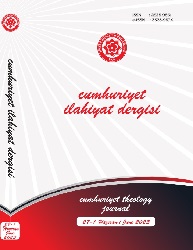Araplarda Şiir: Kadim Edebî Türün Kültürel Özellikleri ve Maddi Destekçileri
Poetry in Arabs: Cultural Characteristics and Financial Supporters of the Ancient Literary Genre
Author(s): Ferruh KahramanSubject(s): Cultural history, Poetry, Theory of Literature, Rhetoric
Published by: Cumhuriyet Üniversitesi İlahyat Fakültesi
Keywords: Arabic Language and Rhetoric; Arab; Poem; Culture; Symbol;
Summary/Abstract: The subject of this study is Poetry in Arabs: Cultural Characteristics and Financial Supporters of the Ancient Literary Genre. The problem of this study is to evaluate poetry from the perspective of culture in Arabs and to question aesthetic, symbolic and semantic dimension of poetry. In this article, not only Arabic poetry is evaluated in terms of culture; the cultural dynamics that enable the development of poetry are also emphasized. There have been great developments in social studies in the modern period. New sciences such as sociology, anthropology, archaeology and cultural history were formed. Among these sciences, sociology primarily focused on Western societies, while anthropology investigated non-Western societies. Archaeology and anthropology have studied human diversity in ancient societies and peoples. As a result of these studies, a lot of data has been collected about the cultures of existing and ancient societies; the history of humanity has been tried to be understood and its future has been tried to be predicted. However, while the poetry of the Arabs, which is one of the ancient societies, is known by everyone and the Arabs are an advanced society in poetry, the cultural aspect of poetry has not been adequately evaluated. Recent studies in this field are a repetition of the past as a method. These studies are certainly important, but as in the past, Arabic poetry is discussed in the context of history, content, form, subject and poets with the beginning date of poetry and the fairs where poetry was performed are emphasized. However, it is time to consider Arabic poetry around the cultural corpus, which is considered important today, with the dynamics of culture and cultural perspective. Therefore, in this study, ancient Arabic poetry has been evaluated in terms of culture. In this study, document analysis, one of the qualitative method techniques, was used. Art takes its inspiration from everyday life and contains many elements of it. Art works also contain religious, social, economic, geographical and ceremonial elements. In art, sometimes aesthetics came to the fore, and sometimes functionality does. Throughout history, art has preserved its functional characteristics as well as its aesthetic value. Another feature of art is that it is created collectively and socially. Even if art is produced purely aesthetically, it never loses its collective and social aspect. Because the work of art is intertwined with technology and social values and is the result of many human efforts from production to consumption. The art and the artist have existed and developed throughout history with the support of those who have political and economic power. Considering the poetry of Jahili, its handling together with the fairs indicates its economic aspect; the support of poetry by Kinda, Ghassan and Himyar states also indicates its political aspect. In addition to these, it was seen that some rich merchants and clergy supported the arts. Although the size and form of support for the artist has changed throughout history, the supporter has never changed. Although the artist is a person who seeks freedom in terms of content and form, he has never reached the independence he seeks because he is surrounded by many tools during the art production process. The freedom of the artist occurs when they have economic power. But does every artist have this economic independence? If so, how much do they have? Even if an artist is economically independent, they must either be dependent on the state and big corporations or be part of popular culture. While art’s collective, functional, political and economic aspects point to its general and universal characteristics, it also has local and some special aspects. The social structure, religion, history, culture, geography and language features indicate the local characteristics of the poetry in the formation of Arabic poetry. Because while art of theater developed in Ancient Greece, the above-mentioned features must be considered in the development of poetry in Arabs. During the Jahili period, some of the Arabs were engaged in trade and lived a civilized life in villages and cities, while others led a nomadic life and engaged in animal husbandry. The geography they live in has a great influence on the development of poetry in Arabs. Since the Arabs lived on wide sandy beaches surrounded by mountains, they were away from the complex object structure that would occupy their minds. In the simplicity of the desert and the clarity of the sky, they turned to their inner world and tried to convey their feelings. According to the rule that geography is destiny or people develop according to their geography, Arabs had to deal with trade and animal husbandry in an arid geography. Their dealings with trade both increased their communication with other nations and enabled them to become rich. Another of the most important reasons that increase their communication with other nations is that the Kaaba is located in Mecca. Because, besides being a center of worship, Mecca has also turned into an economic center with the opportunities provided by the pilgrimage.
Journal: Cumhuriyet İlahiyat Dergisi
- Issue Year: 27/2023
- Issue No: 1
- Page Range: 107-119
- Page Count: 13
- Language: Turkish

